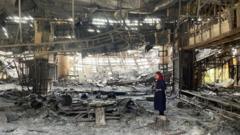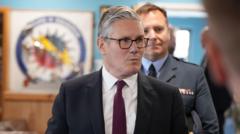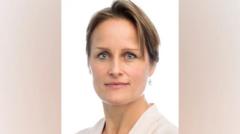Is Tehran's Revival Masking Its Residents' Deep Distress?

The Complex Landscape of Modern Tehran: A City Divided Yet Resilient
In the heart of Tehran, the capital of Iran, a unique coffee experience unfolds at the Boof cafe, nestled in the shadow of the long-closed U.S. embassy. This establishment, with its distinctive iced Americano coffee, serves not just beverages but also a reflection of the city's complex socio-political landscape. The high cement walls adorned with anti-American murals tell a story of a fraught relationship that has persisted since the 1979 Iranian Revolution and the subsequent hostage crisis. As the world watches, Tehran grapples with the weight of its past while navigating an uncertain future.
The Symbolism of the Boof Cafe
Boof cafe offers a unique juxtaposition: on one side, it serves refreshing drinks that provide a momentary escape from the heat; on the other, it is a cultural artifact set against the backdrop of political tension. Amir, a barista at the cafe, expresses a sentiment shared by many Iranians: a desire for improved relations between the U.S. and Iran. He recognizes the impact of U.S. sanctions, which have stifled economic growth and limited travel opportunities for Iranians. The cafe, with its welcoming vibe and cheerful decor, stands as a testament to the resilience and adaptability of the people of Tehran.
The Social Fabric of Tehran
Inside the cafe, a snapshot of daily life unfolds. Two tables are occupied: one by a woman clad in a long black veil, adhering to the traditional dress code, and another by a woman in blue jeans, flouting the regulations and sharing intimate moments with her boyfriend. This small scene encapsulates the diverse expressions of identity within Tehran, where the tension between tradition and modernity continues to shape the lives of its citizens.
Political Tensions and Public Sentiment
The political landscape remains fraught with tension. Iran's Supreme Leader Ayatollah Ali Khamenei recently reiterated the longstanding opposition to American influence, framing it as a struggle for sovereignty. His statements highlight a deep-seated belief that the U.S. seeks to undermine the Islamic Republic. This discourse resonates with many Iranians who feel the weight of history in their daily lives. The political rhetoric surrounding the U.S. and Israel further complicates the situation, especially in light of recent military actions that have left the populace feeling vulnerable and uncertain.
The Aftermath of Conflict
Recent conflicts have exacerbated these feelings. The Iranian health ministry reported over 600 fatalities and thousands of injuries resulting from a 12-day war initiated by Israel. The impacts of this violence are visible in hospitals across Tehran, where healthcare professionals like Ashraf Barghi treat the injured. Nurse Barghi, with over three decades of experience, recounts the severity of the injuries sustained, comparing them to those witnessed during the Iran-Iraq War. The collective trauma from these events continues to shape the psyche of the Iranian people, who now grapple with a sense of fear and uncertainty about the future.
The Resilience of Tehran's Citizens
Despite the backdrop of conflict and political strife, Tehran is slowly beginning to return to its vibrant rhythm. The infamous traffic is re-emerging, and shops are reopening in the bazaars, signaling a cautious return to normalcy. However, behind this facade of recovery lies a deep sense of sadness and disillusionment among the citizens. Young individuals like Mina express their heartbreak over the current state of affairs, lamenting the lost opportunities and the seeming lack of a promising future.
The Power of Unity Amidst Division
On a warm summer's evening, a concert at the Azadi Tower brings together a crowd of diverse backgrounds, united by a shared concern for their nation's future. The Tehran Symphony Orchestra performs beloved patriotic songs, fostering a sense of community in a city marked by division. This gathering underscores the desire for dialogue and understanding, as citizens from varying political viewpoints come together, hoping their voices will be heard by those in power.
The Role of Media in Shaping Perceptions
In this volatile environment, the role of media cannot be understated. International correspondents, including Lyse Doucet, navigate stringent regulations imposed by the Iranian authorities, which restrict the dissemination of information. Such limitations highlight the broader challenges faced by journalists attempting to present an accurate portrayal of life in Iran. The media's portrayal of events can significantly influence public perception, both domestically and internationally.
Finding Hope in Uncertain Times
As Tehran continues to navigate the complexities of its political landscape and the ramifications of recent conflicts, the resilience of its people shines through. The desire for change, freedom, and a brighter future persists among Iranians, despite the challenges they face. Conversations about the need for greater freedoms and improved relations with the outside world echo throughout the city, reflecting a collective yearning for a better tomorrow.
Conclusion: A City at a Crossroads
Tehran stands at a crossroads, grappling with its historical burdens while aspiring to forge a path toward a more hopeful future. The juxtaposition of cafes like Boof against the backdrop of political murals illustrates the complexity of life in this city. Iranians are caught in a struggle between tradition and modernity, aspiration and reality. As they navigate these uncertain times, one thing remains clear: the resilience of Tehran's citizens is a powerful force that will shape the city's destiny.
FAQs
What is the significance of the Boof cafe in Tehran?
The Boof cafe serves as a cultural symbol, providing a space for social interaction amidst the political tensions surrounding the U.S. and Iran. It reflects the resilience and adaptability of Tehran's citizens.
How has the recent conflict affected Tehran's population?
The recent conflict has resulted in significant casualties and injuries, leaving the population with a sense of fear and uncertainty about the future. Hospitals continue to treat those affected, and the emotional toll is palpable among citizens.
What role does media play in Iran's political landscape?
Media serves as a critical platform for shaping public perceptions. However, strict regulations imposed by the Iranian government limit the ability of journalists to report freely, impacting the dissemination of information.
As Tehran continues to evolve amidst its historical challenges, what steps do you think are necessary for the people of Iran to achieve a brighter future? #Tehran #Iran #Resilience
Published: 2025-06-27 10:20:08 | Category: technology



